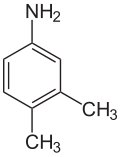3,4-Xylidine
 | |
| Names | |
|---|---|
| IUPAC name
3,4-Dimethylbenzene-1-amine | |
| Other names
3,4-Dimethylaniline 3,4-Dimethylphenylamine 3,4-Dimethylbenzenamine | |
| Identifiers | |
| 95-64-7 | |
| 3D model (Jmol) | Interactive image |
| ChEBI | CHEBI:39901 |
| ChemSpider | 6978 |
| ECHA InfoCard | 100.002.217 |
| |
| |
| Properties | |
| C8H11N | |
| Molar mass | 121.18 g·mol−1 |
| Melting point | 51.0 °C (123.8 °F; 324.1 K) |
| Boiling point | 226.0 °C (438.8 °F; 499.1 K) |
| Except where otherwise noted, data are given for materials in their standard state (at 25 °C [77 °F], 100 kPa). | |
| | |
| Infobox references | |
3,4-Xylidine (3,4-dimethylaniline) is a organic compound with formula (CH3)2C6H3NH2. It is an aromatic amine and a xylidine isomer. It is a crystalline solid.[1]
Preparation and applications
The compound is prepared by two routes: hydrogenation of (2-chloromethyl)-4-nitrotoluene and reaction of the bromoxylene with ammonia. It is a precursor for the production of riboflavin (vitamin B2).[1]
Safety
Like other xylidines, 3,4-xylidine has modest toxicity with an LD50 of 812 mg/kg when administered orally to rats.[1]
In 2003, more than twenty US Army troops were allegedly exposed to 3,4-xylidine during the occupation of Iraq, leading to a number of health complaints.[2]
References
- 1 2 3 M. Meyer "Xylidines" in Ullmann's Encylclopedia of Industrial Chemistry, Wiley-VCH, Weinheim, 2012. doi:10.1002/14356007.a28_455
- ↑ "12 Years Later, a Mystery of Chemical Exposure in Iraq Clears Slightly". New York Times. May 14, 2015.
This article is issued from Wikipedia - version of the 3/16/2016. The text is available under the Creative Commons Attribution/Share Alike but additional terms may apply for the media files.